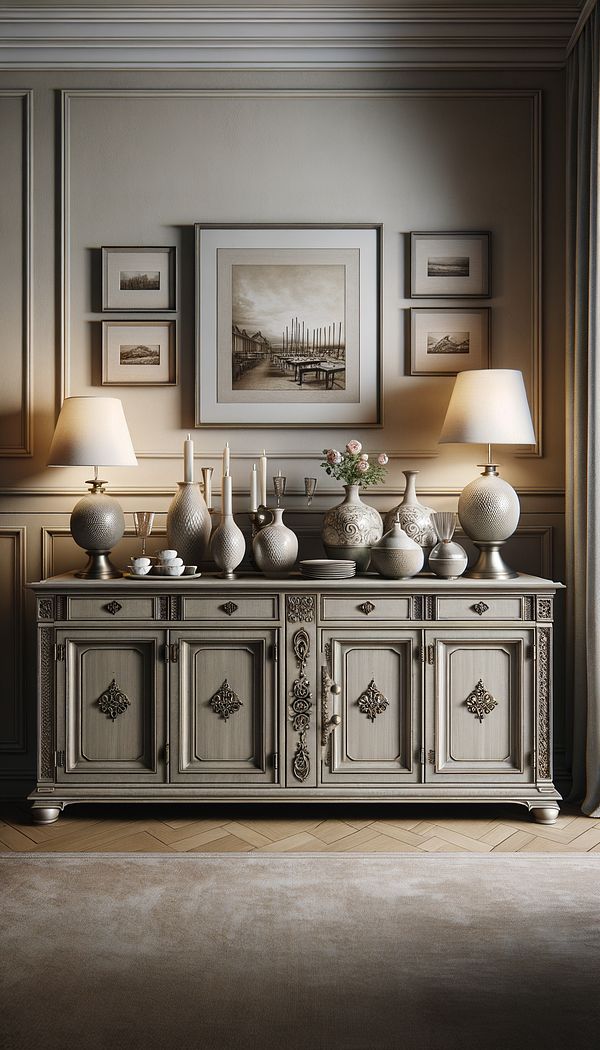What is Sideboard?
A sideboard is a long, low piece of furniture used for storage and displaying items, traditionally found in dining rooms.
Description
In the realm of interior design, a sideboard is an incredibly versatile piece of furniture that not only adds to the aesthetic appeal of a space but also serves a practical function. Typically, sideboards are long, low cabinets that stand on short legs or have a base that sits directly on the floor. They usually feature a combination of drawers, shelves, and sometimes cabinets, offering ample storage space. Traditionally, sideboards are used in dining rooms to store table linens, serving dishes, silverware, and other dining essentials. However, their functionality extends beyond the dining room, making them a popular choice for living rooms, hallways, and even bedrooms.
One of the key characteristics of a sideboard is its surface area which provides an ideal space for displaying decorative objects, art and sculpture, or even serving food during gatherings. This feature sets sideboards apart from other storage units like cabinets and dressers, which typically don't offer the same amount of display space on top. Over time, the design of sideboards has evolved to match various design styles, ranging from traditional and rustic to modern and minimalist. This makes them a flexible piece of furniture that can suit a wide range of interior design themes.
Sideboards are often crafted from a variety of materials, including wood, metal, and glass, or a combination thereof. The choice of material can significantly influence the overall look and feel of the piece, as well as its durability and maintenance requirements. Additionally, many sideboards feature intricate detailing, such as carved wood or ornate hardware, which adds to their decorative appeal.
Usage
A traditional use of a sideboard is in a formal dining room, where it serves as a storage unit for dinnerware and a surface for food during buffet-style meals. In more contemporary settings, sideboards can be found in entryways, where they provide storage for keys, mail, and other small items, and in living rooms, where they may be used to house multimedia equipment or display family photos and heirlooms. In both contexts, the top surface of the sideboard often features decorative elements such as vases, lamps, or books.
FAQs
-
Can a sideboard be used as a TV stand?
Yes, a sideboard can be used as a TV stand. Its long, low profile makes it suitable for supporting a television, while the storage space can be used to house media devices, cables, and other TV-related accessories.
-
How do I choose the right sideboard for my space?
When choosing a sideboard, consider the size of your room, the available space, your storage needs, and your interior design style. Look for a sideboard that complements your existing decor and is proportionate to the room. Material, color, and design details should also align with your aesthetic preferences.
-
Can sideboards be used in small spaces?
Yes, sideboards can be used in small spaces. Opt for a compact design with ample storage to maximize functionality without overwhelming the space. Consider a sideboard with vertical storage elements, like shelves or cabinets, to make the most of limited floor space.
Practical Application
To effectively incorporate a sideboard into your interior design, consider its placement carefully. A sideboard can act as a focal point in a room, so position it where it can be appreciated both for its aesthetics and functionality. In the dining room, place it along a wall near the dining table to facilitate serving and storage. In living areas, use it to anchor a space or to define separate areas within an open-plan layout. When styling the top, balance decorative items with practical pieces or consider a mix of art and sculpture, lamps, and functional but beautiful storage containers. Remember that the sideboard's surface is an opportunity to add personality and charm to your space.
-
CanterburyA Canterbury is a type of portable, open-topped furniture designed to hold sheet music or books.
-
Split LeatherSplit leather is a type of leather made from the lower layers of a hide, split off from the upper, more valuable layers.
-
Split-Back SofaA split-back sofa is a versatile piece of furniture featuring a backrest that is divided into two or more sections, each of which can be adjusted independently.
-
CauseuseA causeuse is a small sofa, typically designed to seat two people.
-
TV StandA piece of furniture designed to support a television and related media equipment.
